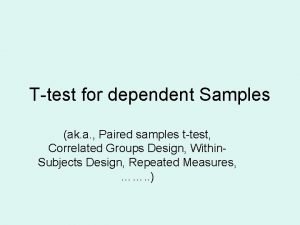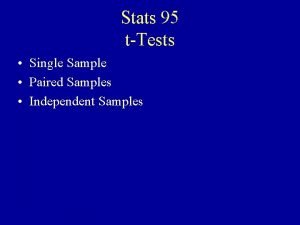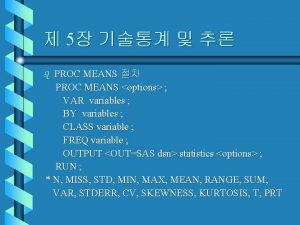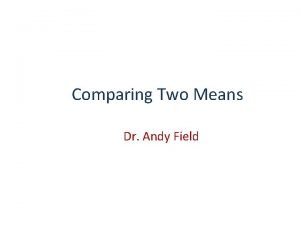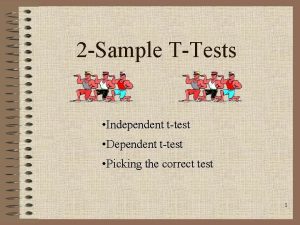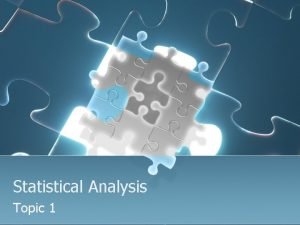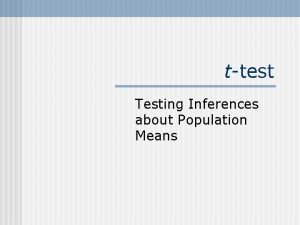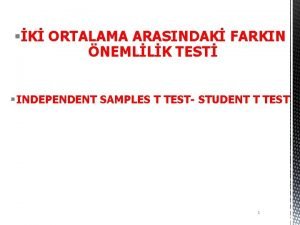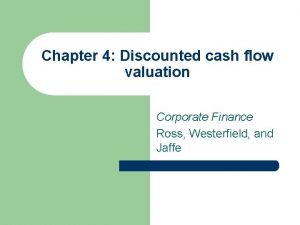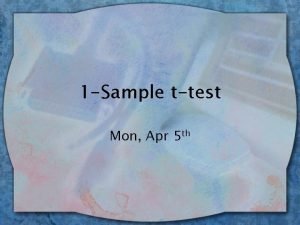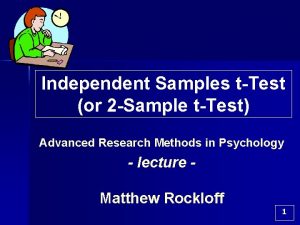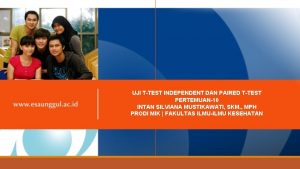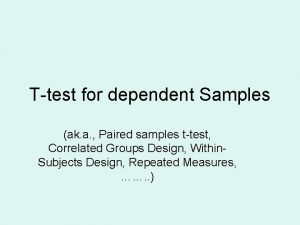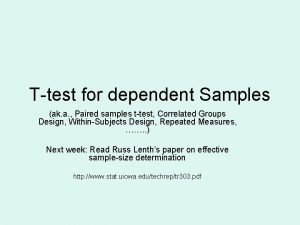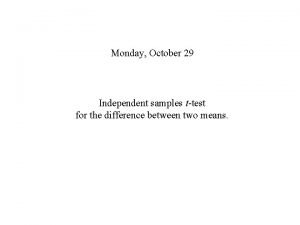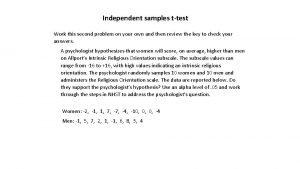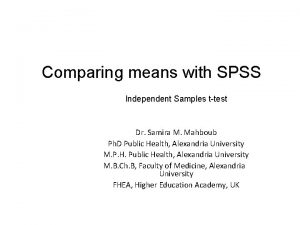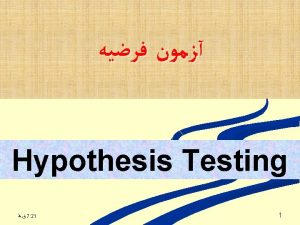Independent Samples ttest Mon Apr 12 th t













- Slides: 13

Independent Samples t-test Mon, Apr 12 th

t Test for Independent Means w Comparing two samples – e. g. , experimental and control group – Scores are independent of each other w Focus on differences betw 2 samples, so comparison distribution is: – Distribution of differences between means

Hypotheses w Ho: or 1 - 2 = 0 (no group difference) or 1 = 2 w Ha = 1 - 2 not = 0 (2 tailed) or 1 - 2 > or < 0 (if 1 -tailed) w If null hypothesis is true, the 2 populations (where we get sample means) have equal means w Compare T obs to T critical (w/Df= N-2) w If |Tobs| > |T crit| Reject Null

Pooled Variance w T observed will use concept of pooled variance to estimate standard error: – Assume the 2 populations have the same variance, but sample variance will differ… – so pool the sample variances to estimate pop variance – Then standard error used in denom of T obs w Note – I’ll show you 2 approaches (you decide which to use based on what data is given to you)

Finding Estimated Standard Error using SS (lab approach) w Pooled variance (S 2 p) S 2 p = (SS 1 + SS 2) / df 1 + df 2 Where, df 1 = N 1 -1 and df 2= N 2 -1 and SS 2 are given to you w Then use this to estimate standard error: (S xbar 1 –xbar 2) = sqrt [(S 2 p/N 1) + (S 2 p/N 2)] Estimated Standard Error (using x notation)

Estimated Standard Error using S 2 y (sample variances – book & HW approach) w Skip calculating pooled variance and just estimate standard error: Sybar 1 – ybar 2 = sqrt [((N 1 -1)S 2 y 1) + ((N 2 -1)S 2 y 2)] (N 1+N 2) – 2 Estimated Standard Error (using y notation) * Sqrt [(N 1 + N 2)/ N 1 N 2] Note: See p. 480 in book for better representation of this formula!!

T observed w Once you’ve estimated standard error, this will be used in T obs: T obs = (xbar 1 – xbar 2) – ( 1 - 2) S xbar 1 – xbar 2 Always = 0) Estimated Standard Error (doesn’t matter if use x or y notation!)

Example – using 2 S y info w Group 1 – watch TV news; Group 2 – radio news; difference in knowledge? w Ho: 1 - 2 = 0; Ha: 1 - 2 not = 0 – – ybar 1 = 24, S 21 = 4, N 1 = 61 ybar 2 = 26, S 22= 6, N 2 = 21 Alpha =. 01, 2 -tailed test, df tot = N-2 = 80 S ybar 1 -ybar 2 = sqrt[((60)4) +((20)6)] (61 + 21) - 2 = 2. 12 * sqrt [(61 + 21) / 61 *21] = = 2. 12 *. 253 =. 536

w T obs = (24 -26) – 0. 536 = -3. 73 w t criticals, alpha =. 01, df=80, 2 tailed – 2. 639 and – 2. 639 w |T observed | > |T critical| (3. 73 > 2. 639) w Reject null – there is a difference in knowledge based on news source – (check means to see which is best)…radio news was related to higher knowledge. w Note: in lab 22 you’ll use other approach (find SS first, then standard error for T denom); this ex. is how HW will look…

SPSS example w Analyze Compare Means Independent Samples t – Pop up window…for “Test Variable” choose the variable whose means you want to compare. For “Grouping Variable” choose the group variable – After clicking into “Grouping Variable”, click on button “Define Groups” to tell SPSS how you’ve labeled the 2 groups

(cont. ) – Pop up window, “Use Specified Values” and type in the code for Group 1, then Group 2, hit “continue” · For example, can label these groups anything you’d like when entering data. Are they coded 0 and 1? 1 and 2? …etc. Specify it here. – Finally, hit OK – See output example in lab for how to interpret

GSS data example w Ho: male - female = 0, – Ha: difference not = 0 w DV = # siblings w Male xbar = 4. 00, female xbar = 3. 98 w In output, 1 st look at Levene’s test of equality of variances (2 lines) Ho: equal variances: – Equal variances assumed look at sig value – Equal variances not assumed – If ‘sig value” <. 05 reject Ho of equal variances and look at ‘equal variance not assumed’ line – If ‘sig’ value >. 05 fail to reject Ho of equal variances and use ‘equal variance assumed’ line

(cont. ) w Here, fail to reject Ho, use equal variances assumed – Next, using that line, look for ‘sig 2 -tailed’ value this is the main hypothesis test of mean differences – If ‘sig’ <. 05 reject Ho of no group differences – Here, >. 05, so fail to reject Ho, conclude # sibs doesn’t differ between male/female
 T test for dependent samples formula
T test for dependent samples formula T-test beispielrechnung
T-test beispielrechnung Paired vs independent t test
Paired vs independent t test Proc means options
Proc means options Effect size for t test
Effect size for t test Ttest ind
Ttest ind Graphpad ttest
Graphpad ttest Formula for t test independent samples
Formula for t test independent samples Successive independent samples design examples
Successive independent samples design examples Median
Median Independent samples t test
Independent samples t test Apr vs ear
Apr vs ear Sistem za centralizovano prijavljivanje korisnika apr
Sistem za centralizovano prijavljivanje korisnika apr Apr vs ear
Apr vs ear
